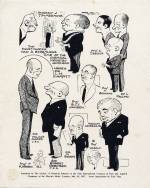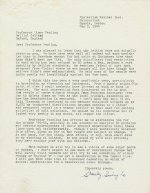|
Along with his preliminary results, Itano suggested in a 1948 report that there were
eight other options for immediate research, one of which eventually proved successful:
"electrophoretic studies on normal and sickle cell hemoglobin." In his synopsis about
electrophoresis, Itano briefly mentioned the preliminary status of electrophoretic
studies on hemoglobin and its possible utility for his research. Itano stated later
that he initially tried electrophoresis because the apparatus was available and required
small amounts of blood. At the time, Caltech had a problem getting adequate samples
of blood from people with sickle cell anemia. Pauling finally obtained a regular supply
in May 1949 from Dr. George Burch of Tulane University.
Electrophoresis uses electric currents to examine substances that have varying surface
charges, and therefore is especially helpful in analyzing proteins. Protein samples
in a buffer solution are run through the electrophoresis apparatus, which creates
a moving boundary. Moving boundary electrophoresis indicates whether a protein has
an overall positive or negative charge on its surface area. The rate of a moving boundary
can be manipulated by changing the pH of the solution and hence, the charge of the
particles.
Since moving boundary electrophoresis was a relatively new technique in 1948, only
about fifty laboratories in the United States had electrophoresis machines. Mass production
of the apparatus began after 1950, so that prior to mid-century, laboratories built
them. Pauling asked the Rockefeller Foundation in 1941 for money for immunology research,
including the construction of a Tiselius electrophoresis apparatus. Caltech received
enough money from the Rockefeller Foundation to build the machine, to which Stanley M. Swingle, a general chemistry instructor at Caltech, made improvements. It was this machine
that Itano and Seymour Jonathan Singer used for the experiments reported in the 1949 article.
Pauling's request for money to build an electrophoresis machine was most likely influenced
by Karl Landsteiner's infatuation with the device. Landsteiner, Pauling's mentor in
immunology, analyzed blood sera with electrophoresis beginning in 1908. When Landsteiner
learned of Arne Tiselius's improved apparatus in 1937 he immediately began using the technique as a standard
procedure in his researches.
|
|
Click images to enlarge

Cartoon caricatures of Linus Pauling, Jean Timmermans, Arne Tiselius, L. H. Lampitt,
Robert Bienaime, B. C. T. Jansen, Viscount Leverhulme, Wallace Akers, Marston T. Bogert,
Robert Robinson, Paul Karrer and Professor Vesely. June 18, 1947.

Letter from Stanley Swingle to Linus Pauling. May 2, 1948.
"The item of $7,500 for apparatus, supplies, animals would permit us to use the large
number of animals required for some of our projected researches, and should permit
also the construction of a Tiselius apparatus for the electrophoretic separation of
antibody fractions by the suggested method of combination with charged haptens, and
for other investigations."
|

